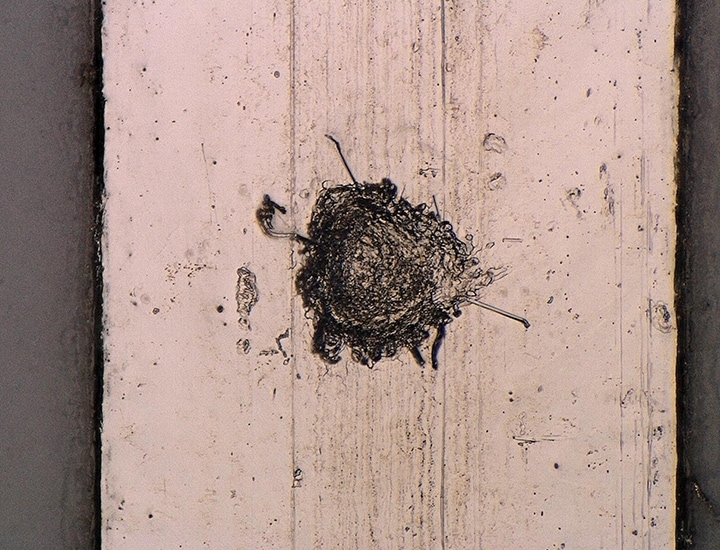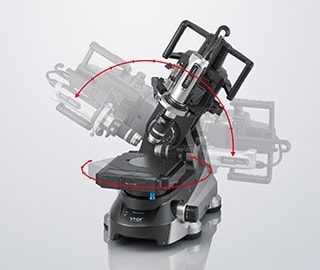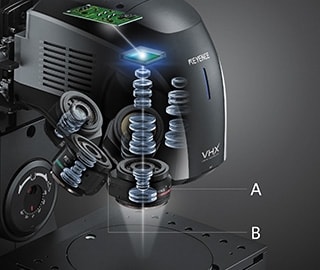Causes of Tin Whiskers and Solutions for Problems in Testing, Observation, and Evaluation
"Whiskers," which occur and grow by various factors, can cause problems, such as short-circuiting, in electrical devices and electronic devices on the market, and thus countermeasures need to be taken. This section explains whisker causes, growth mechanisms, and environments as well as various evaluation tests for whiskers. This section also introduces examples of using KEYENCE’s latest 4K Digital Microscope to improve problems in tin whisker observation.

- Problems and Causes of Whiskers
- Testing, Observation, and Evaluation of Tin Whiskers
- Latest Solution Examples for Problems in Tin Whisker Observation and Evaluation
- The New Standard for Observation of Tin Whiskers that Grow in Three Dimensions
Problems and Causes of Whiskers
Whiskering is a phenomenon in which a monocrystal of metal spontaneously grows on a metal surface. Whiskering occurs especially on tin (Sn) plating and zinc (Zn) plating. The word "whisker" refers to the whiskers that many mammals—including cats and mice—have, so this phenomenon indicates the needle- or nodule-like projections that grow on metallic crystals.
Problems and history of whiskers
Whiskers that grow in an electric circuit or joint section can cause short-circuits, leading to failures of electrical products, electronic circuits, and electronic devices.
In 1946, there were many failures in products on the market caused by short-circuits in radios that used variable capacitors plated with cadmium. This put the spotlight on cadmium whiskers.
In the 1950s, a small amount of lead was added to an alloy to slow down whisker growth and this countermeasure spread widely. Since 2000, with the trend to ban the use of lead in products, tin plating has come into use. The use of tin plating, however, led to whiskers causing failures in many products from wristwatches to nuclear reactors to even products in the aerospace field including NASA’s artificial satellites and space shuttles, leading to a re-focusing on whiskers as an important issue.
Causes of whiskers
Whiskers are believed to occur mainly due to influences from the following factors:
- Diffusion in intermetallic compounds
- Galvanic corrosion*
- External stress
- Stress generated by a difference in the coefficient of thermal expansion
With many other possible factors, the underlying mechanism of whiskering is still unclear.
Galvanic corrosion, also known as bimetallic corrosion, occurs when two or more different metals are brought into electrical contact and there is a potential difference between them.
Environments where whiskers occur
Tin whiskers and zinc whiskers occur and grow easily because their atoms actively diffuse at around room temperature. The diffusion is usually driven by the following environmental influences. The following are typical environmental factors whiskers may occur.
- Room temperature
- Temperature cycling
- Oxidation and corrosion
- External pressure
- Electromigration*
Whiskers occur due to electromigration in semiconductors having high current density or special packaging such as flip chip packaging.
Electromigration is the transportation of metal atoms caused by the electric current that passes through an integrated circuit. For example, in an aluminium wire, whiskers and hillocks can occur and grow at the anode as a result of aluminium atoms moving in the direction of the flow of electrons.
Testing, Observation, and Evaluation of Tin Whiskers
Because the occurrence and growth of tin whiskers, in particular, can cause electrical and electronic products to fail, various tests, observations, and evaluations are conducted to implement countermeasures. This section introduces typical tests and conditions used to evaluate tin whiskers. It also introduces the current situation in and trend of observation and evaluation.
Examples of tin whisker evaluation tests
Examples of the types and conditions of tests currently conducted to evaluate tin whiskers are shown below.
- Room temperature storage test
- Observation of the growth of tin whiskers that occur due to the influence of diffusion in intermetallic compounds
Environment: 30 ±2°C/60 ±3%RH, time: 4000 hours
- Constant temperature and humidity test
- Observation of the growth of tin whiskers that occur due to galvanic corrosion
Environment: 55 ±3°C/85 ±3%RH, time: 2000 hours
- Temperature cycle test
- Observation of the growth of tin whiskers that occur due to a difference in the coefficient of thermal expansion
Environment: low temperature −55 ±5°C or −40 ±5°C/high temperature 85 ±2°C or 125 ±2°C, number of cycles: 2000
- External stress test
- Observation of the growth of tin whiskers that occur due to the influence of external stress
Type: connector engagement test (using actual products), load test (using a zirconia ball with a diameter of 0.1 mm and a load of 300 gf for 500 hours)
Magnified observation and evaluation, which are key countermeasures for tin whiskers
It is possible to understand product failure risks in advance and take proactive countermeasures for such risks if the conditions of tin whisker occurrence and growth can be analysed and evaluated using magnified observation in each test. These risks can be understood and these countermeasures can be taken because important information for research and development, circuit design, material selection, and manufacturing of the electrical products and electronic devices can be obtained before such products are released to the market.
For magnified observation of tin whiskers, general optical microscopes or scanning electron microscopes (SEMs) have been used. Instead of light, SEMs use a beam of electrons that have a short wavelength to perform nano-order observation. In recent years, however, breakthroughs in optical system and image processing technologies have led to the development of digital microscopes that enable observation with clear images and simple operations. Such digital microscopes can be used to observe and evaluate tin whiskers effectively with clear images.
Latest Solution Examples for Problems in Tin Whisker Observation and Evaluation
KEYENCE’s VHX Series ultra-high definition 4K Digital Microscope uses cutting-edge technology—such as a high-resolution lens, a 4K CMOS image sensor, an imaging engine, and lighting—to enable magnified observation using clear 4K images quickly with simple operations. This section introduces solution examples for problems in conventional tin whisker observation and evaluation.

Solutions to problems in tin whisker observation using SEMs
With the VHX Series 4K Digital Microscope
The newly developed optical system and 4K CMOS image sensor eliminate the need for vacuum chambers, making it possible to observe targets in non-vacuum environments while tracking the field of view at magnifications of up to 6000x. Observation is possible with clear, high-resolution 4K images and without any time-consuming preparation.
With the free-angle observation system and high-accuracy XYZ motorised stage, field-of-view alignment, rotation, and oblique axis motion are optimally performed for tilted observation, thereby allowing users to observe freely and easily from any angle.
Furthermore, real-time composition enables observation with images fully focused on the entire sample while maintaining high magnification and resolution. With a click on the location to observe on the overall image, real-time composition automatically moves the stage, brings the sample into focus, and performs depth composition, which not only saves many steps for sample positioning but also makes observation more efficient.

Solutions to problems in tin whisker observation using microscopes
With the VHX Series 4K Digital Microscope
The high-resolution lenses and the motorised revolver enable magnified observation with clear 4K images through seamless zoom between 20x and 6000x without lens replacement.

- A. High-resolution lens
- B. Motorised revolver
Real-time composition, which includes depth composition, brings an entire target into full focus, even when the target has surface irregularities due to tin whiskers, while maintaining high magnification and high resolution. With a click on the location to observe on a fully focused image, real-time composition automatically moves the stage and brings the target into focus, thus dramatically improving the work efficiency.
Using the free-angle observation system and high-accuracy XYZ motorised stage enables tilted observation. Grown tin whiskers forming nodule-like projections can be effectively observed at the desired location and from the desired angle.
The New Standard for Observation of Tin Whiskers that Grow in Three Dimensions
In addition to the functions introduced here, the VHX Series high-definition 4K Digital Microscope is equipped with many other functions, such as 3D measurement, which enables 3D shape measurement and profile measurement of tin whiskers; reproduction, which automatically reproduces image capture conditions; and report creation.
The VHX Series high-definition 4K Digital Microscope allows users to quantify and streamline observation, analysis, and measurement of tin whiskers that grow in three dimensions, bringing numerous advantages to various sites related to electrical products and electronic devices.
For details on the VHX Series, click the button shown below to download the catalogue. For inquiries, click the other button shown below to contact KEYENCE.


